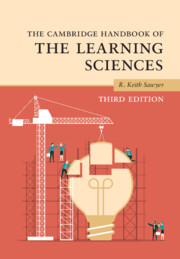Book contents
- The Cambridge Handbook of the Learning Sciences
- The Cambridge Handbook of the Learning Sciences
- Copyright page
- Contents
- Figures
- Tables
- Contributors
- Preface
- 1 An Introduction to the Learning Sciences
- Part I Foundations
- Part II Methodologies
- Part III Grounding Technology in the Learning Sciences
- Part IV Learning Together
- Part V Learning Disciplinary Knowledge
- 23 Research in Mathematics Education
- 24 Science Education and the Learning Sciences
- 25 Complex Systems and the Learning Sciences
- 26 Learning History
- 27 Learning to Be Literate
- 28 Arts Education and the Learning Sciences
- Part VI Moving Learning Sciences Research into the Classroom
- Index
- References
24 - Science Education and the Learning Sciences
A Coevolutionary Connection
from Part V - Learning Disciplinary Knowledge
Published online by Cambridge University Press: 14 March 2022
- The Cambridge Handbook of the Learning Sciences
- The Cambridge Handbook of the Learning Sciences
- Copyright page
- Contents
- Figures
- Tables
- Contributors
- Preface
- 1 An Introduction to the Learning Sciences
- Part I Foundations
- Part II Methodologies
- Part III Grounding Technology in the Learning Sciences
- Part IV Learning Together
- Part V Learning Disciplinary Knowledge
- 23 Research in Mathematics Education
- 24 Science Education and the Learning Sciences
- 25 Complex Systems and the Learning Sciences
- 26 Learning History
- 27 Learning to Be Literate
- 28 Arts Education and the Learning Sciences
- Part VI Moving Learning Sciences Research into the Classroom
- Index
- References
Summary
The chapter discussed four areas where the learning sciences and research on science education have worked together synergistically. First is the shift away from viewing learning as an individual cognitive process to the idea that knowledge and learning are situated in social and cultural context. Second is the exploration of what learning outcomes should be the focus. Learning outcomes have shifted from memorizing content knowledge to mastering the practices of science, such as the ability to solve open-ended and ill-structured problems. Third is the focus on pedagogy: what classroom practices would best support learning of scientific practice in addition to content knowledge? Fourth is a shift in the target audience for who should learn science. The shift has been away from the idea that only talented students should learn science and enter scientific careers, from a belief that science literacy is important for all students and citizens.
Keywords
- Type
- Chapter
- Information
- The Cambridge Handbook of the Learning Sciences , pp. 486 - 503Publisher: Cambridge University PressPrint publication year: 2022
References
- 2
- Cited by



